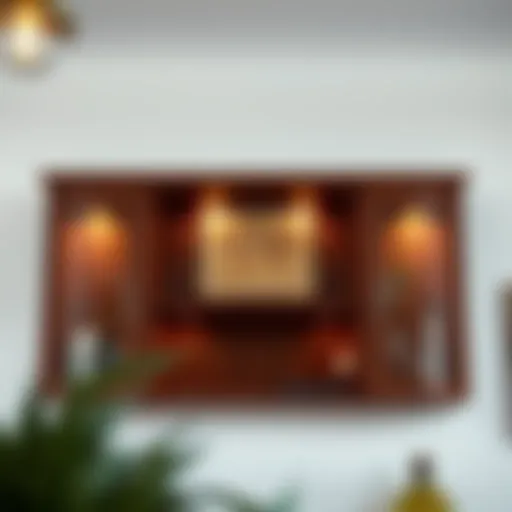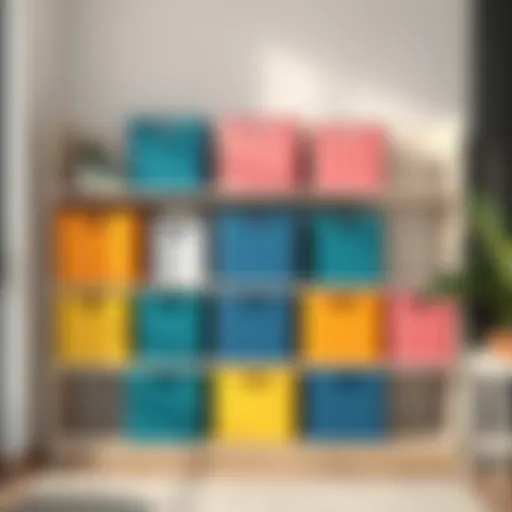Maximize Workspace Efficiency with Desk Tray Organizers


Intro
In today’s world, where distractions abound, maintaining an organized workspace is no longer a luxury but a necessity. Desk tray organizers serve as the backbone of an efficient work environment, allowing individuals to corral their supplies and minimize the chaos that commonly leads to lost focus. Understanding the different types of desk tray organizers available, their material choices, and how they fit into various decor styles can significantly enhance productivity and elevate the overall aesthetic of a workspace.
As the importance of first impressions in the professional realm cannot be overstated, a tidy desk reflecting your style does wonders for not just your image, but also your mood. Whether you are a homeowner looking to enhance your home office, a designer seeking inspiration, or an enthusiastic DIYer inspired by the latest trends, this guide offers valuable insights into desk tray organizers, how to select the right ones, and the nuances involved in keeping them pristine.
Furniture Styles and Trends
When it comes to designing a functional workspace, the choice of desk tray organizers should not be underestimated. Their style and material should resonate with the broader themes of the space, whether leaning into modernity or embracing tradition.
Modern vs. Traditional: Understanding the Aesthetics
In modern interiors, minimalism reigns supreme. Here, desk tray organizers are typically sleek, with clean lines and a streamlined design. Materials like acrylic, metal, or glass are commonplace, reflecting a contemporary ethos where form merges cohesively with function. These organizers are often transparent or monochromatic, ensuring they do not visually clutter a workspace.
Conversely, traditional desk tray organizers evoke warmth and sophistication. Crafted from rich woods or embellished with intricate details, they add a touch of character to a workspace. These organizers often feature rich, dark stains or polished finishes that complement classic styles.
Color and Material Trends: What's In and What's Out
The color palette for desk tray organizers is evolving. Currently, neutral shades such as soft grays, whites, and earthy tones dominate. These hues not only blend seamlessly with various decor styles but also promote a calming atmosphere conducive to concentration. Think about avoiding overly vibrant or distracting colors that could pull focus away from work tasks.
In terms of materials, sustainable options are on the rise. Bamboo and recycled materials are gaining popularity among environmentally-conscious consumers. Using these materials not only makes a statement about personal values but also contributes to a trend towards eco-friendliness in workspace design.
Furniture Care and Maintenance
Proper care and maintenance of desk tray organizers ensure longevity and continuous appeal. By adhering to simple guidelines, one can keep these organizers functioning well while retaining their aesthetic charm.
Tips for Prolonging the Life of Your Furniture
- Regular Cleaning: Dust and debris can accumulate quickly. A simple microfiber cloth can work wonders in keeping surfaces clean.
- Avoid Direct Sunlight: Excessive exposure can fade colors, especially in wooden organizers. Keep desks out of direct sunlight if possible.
- Protective Coatings: For wooden pieces, applying a clear coat can safeguard against scratches and spills.
- Proper Placement: Ensure items are placed evenly so that weight distribution does not affect stability or integrity over time.
DIY Repair Hacks for Common Furniture Issues
- Scratches on Wood: A mixture of walnut oil and vinegar can help disguise minor scratches.
- Cleaning Stains: For acrylic organizers, a diluted rubbing alcohol solution can effectively clean stains without damaging the surface.
Below are some resources that can provide additional valuable insights:
- Wikipedia Article on Furniture
- Britannica's Guide on Interior Design
- Reddit Community on Home Decor
- National Resource on Sustainable Materials
Integrating desk tray organizers into your workspace is not just about decluttering; it's an invitation to create a reflective, organized environment that nurtures productivity and creativity. Let’s explore the various options available that can seamlessly blend functionality with visual appeal.
Prolusion to Desk Tray Organizers
In today's fast-paced world, maintaining an organized workspace is more critical than ever. Desk tray organizers provide a practical solution to this common dilemma, transforming chaotic desktops into streamlined environments conducive to productivity. An essential aspect of modern office aesthetics, these organizers effectively blend function with style. They not only help in minimizing clutter but also serve as visual elements that can enhance the overall decor of a workspace.
Defining Desk Tray Organizers
Desk tray organizers, in simple terms, are specialized containers designed to hold and organize various office or personal items. They can vary widely in shape, size, and design. From multi-tiered trays that stack high to compartments for holding everything from letters to loose papers, each organizer plays a distinct role in helping users manage their belongings effectively. Essentially, these organizers are the unsung heroes of an orderly desk, often overlooked until the chaos becomes too much to bear.
Purpose and Benefits
The primary purpose of desk tray organizers is to create more efficient workspaces by reducing clutter. Here’s a closer look at their myriad benefits:
- Enhanced Efficiency: By providing designated spaces for specific items, desk tray organizers save valuable time. No more sifting through piles of documents to find that important report—everything has its place.
- Aesthetic Appeal: A well-organized desk is visually pleasing. Suitable designs and materials can complement the decor, making the workspace not only functional but also stylish.
- Stress Reduction: Clutter can be overwhelming. Desk organizers help in reducing visual chaos, thereby promoting a calmer working atmosphere.
- Flexibility: Many organizers offer options for customization, allowing individuals to adapt them according to their changing needs or preferences.
"An organized workspace reflects an organized mind," a common saying that holds true in numerous scenarios.
Types of Desk Tray Organizers
Desk tray organizers come in various forms, each tailored to meet different needs and preferences. Understanding the types available is crucial, as it allows users to select the right one that aligns with their workspace requirements and design aesthetics. When one finds themselves buried under a mountain of papers or office supplies, the right organizer can be a game-changer. With a combination of function and style, these organizers can transform cluttered desks into organized havens.
Stackable Organizers
Stackable organizers offer versatility and space-saving solutions. They can be stacked vertically, taking up minimal space while still providing ample storage. This design is particularly beneficial in smaller workspaces, where every inch counts.
- Benefits:
- Considerations:
- Increased functionality without a sprawling footprint.
- Easy access to multiple trays without the need for constant rearrangement.
- Ensure that the materials are sturdy enough to hold weight.
- Assess the height of the stacks; too high might make it difficult to reach the bottom tray.
Stackable organizers suit various materials like metal, plastic, or wood, accommodating diverse aesthetic styles. As a homeowner or designer, think about how the color and material echo the overall theme of your workspace.


Expandable Trays
Expandable trays are a flexible solution for organizing items of varying sizes. They can be adjusted or expanded to accommodate different contents, making them ideal for fluctuating office supplies. This adaptability is particularly valuable in environments where demands change frequently.
- Advantages:
- Things to Keep in Mind:
- Customizable compartments allow for separating larger items from smaller ones.
- Reduced chances of items getting lost in the tray.
- Look for durable mechanisms that won’t wear out with repeated adjustments.
- Consider the physical space available on your desk and how much width the expanded tray could consume.
Danishing the functionality of a desk, getting an expandable organizer can streamline the work process, enabling swift access to the tools needed.
Multi-Compartment Organizers
Multi-compartment organizers represent an essential choice for anyone looking to maximize efficiency. With distinct sections, they allow for categorizing items by type or purpose. This organization can foster improved focus and workflow, enabling users to locate what they need at a glance.
- Key Benefits:
- What to Evaluate:
- A clear distinction between various supplies reduces time spent searching.
- Allows personalization; each compartment can be tailored to specific needs.
- The layout should fit your working style. Are you often reaching across your desk?
- Balance between size and the number of compartments. Too many might become overwhelming.
Epilogue
In choosing the right type of desk tray organizer, it’s beneficial to consider your workspace needs, aesthetic preferences, and how you work best. Combining these elements ensures that your chosen organizer not only fosters productivity but also enhances the overall appeal of your workspace.
Remember, the right organization can tune chaos into calm, setting the stage for a day of efficiency and focus.
Materials Used in Desk Tray Organizers
Selecting the appropriate materials for desk tray organizers is crucial for both functionality and aesthetics. The materials chosen can impact durability, design, and even the way a workspace feels. Understanding these materials helps homeowners, designers, and DIY enthusiasts make informed choices that align with their needs and preferences. Each material brings its own unique set of benefits and considerations, making this a key aspect to consider when purchasing or creating desk tray organizers.
Wood Options
Wooden desk tray organizers exude a natural charm that can elevate the look of any workspace. They come in various finishes, allowing you to match them with existing furniture. Common woods include oak, pine, and walnut, each offering distinct grain patterns and colors. The process of selecting wood can be a balance between sturdiness and aesthetics.
- Durability: Well-crafted wooden organizers are often robust and can withstand daily wear.
- Customization: Many wooden options allow for personal touches, like engraving or painting. This can make them more unique and resonate with your personal style.
- Sustainability: Opt for sustainably sourced wood to ensure you're making an eco-friendly choice.
However, wood can require more maintenance than other materials, needing occasional polishing or refinishing to keep it looking its best.
Metal and Wire Designs
Metal and wire organizers present a more modern aesthetic, often appealing to those who appreciate minimalist design. These materials can be both sleek and functional, offering durability that wood may not provide.
- Robustness: Metal can endure significant stress and inflictions without a dent, making it ideal for heavy-duty use.
- Ventilation: Wire designs promote airflow, which is beneficial for storing electronic devices or supplies that might need a bit of breathing room.
- Variety of Finishes: With options in stainless steel, galvanized metal, or even coated finishes, the look can be tailored to individual tastes.
Yet, it's worth noting that metal can be prone to scratching and may lose luster over time if not cared for properly.
Plastic and Acrylic Alternatives
Plastic and acrylic organizers have gained popularity due to their versatility and affordability. They offer a lightweight solution without sacrificing style. Many admire how these materials can mimic the look of glass or more expensive finishes.
- Cost-effective: Generally, these options are more budget-friendly than wood or metal.
- Variety of Colors: Plastic and acrylic organizers come in a plethora of colors and transparent styles, making it easy to inject some personality into a workspace.
- Easy to Clean: Unlike wood, plastic can be wiped down with a damp cloth, making it a low-maintenance choice.
While plastic may not have the same aura of sophistication as wood or metal, its practicality makes it a worthy contender.
In summary, the choice of materials profoundly affects the function and aesthetics of desk tray organizers, influencing everything from durability to overall look. Homeowners and designers should weigh these factors carefully to find the best fit for their needs.
For further insights about these materials and how they relate to sustainability in workspace organization, visit Wikipedia, or check out resources from The Spruce.
Choosing the Right Desk Tray Organizer
Selecting the right desk tray organizer is pivotal, as it sets the tone for both aesthetic and functional aspects of your workspace. An effective organizer can transform a chaotic desk into a haven of efficiency. Before diving into the sea of options available, it’s essential to consider specific elements that cater to your unique workspace needs, personal style, and functionality.
Assessing Workspace Needs
Before making a decision, it's wise to assess your workspace needs. Consider the type of activities you engage in daily. Are you often buried under a pile of paperwork? Or perhaps you're a creative soul surrounded by stationery and art supplies? Your needs will significantly dictate the organizer's structure and style.
- Item Volume: The first step is figuring out how much you need to store. Count your items and group them by category; paperwork, office tools, or personal items. This way, you can estimate the size and number of compartments required.
- Space Available: Evaluate your workspace. Is it sprawling or compact? For cramped spaces, a vertical organizer, such as a stackable unit, could save you a ton of space.
- Workflow: Think about your routine. Does your workflow require items being at arm's length? Or are they just for storage? Choose an organizer that complements how you work, so each tool or document is easily accessible without disrupting your pace.
Considering Aesthetics


A desk organizer isn't just functional; it can reflect your style too. Many are tempted to overlook aesthetics, but the visual aspect can enhance the overall feel of your workspace. The right organizer can inspire creativity and enthusiasm simply by being pleasant to look at.
- Color Palette: Think about the colors that resonate with you or fit nicely with your existing decor. Whether it’s a chic black metal piece or a warm wooden tray, the color can set the vibe of your workspace.
- Design Style: Are you going for a modern look or something more rustic? The design should blend seamlessly into your environment rather than clash with it. A minimalist design could provide a sleek, professional appearance, while a more ornate one could add character.
"A well-chosen desk organizer won't just tidy up your desk; it can also elevate your mood and boost creativity."
Functionality and Flexibility
The best organizers do more than just hold items; they optimize your processes. Functionality and flexibility are key factors to consider when choosing an organizer.
- Modular Options: Look for organizers that allow you to add or remove sections. A modular tray can grow as your needs evolve, letting you keep pace with your work demands.
- Multi-purpose Usability: Some desks organizers serve multiple purposes, perhaps incorporating charging stations or compartments for specific gadgets. This kind of versatility can maximize your workspace's potential.
- Ease of Movement: If you find yourself frequently rearranging your workspace, you may want to prioritize lightweight designs or those with wheels. Mobility can add a layer of convenience that simply won't exist with stationary, heavier alternatives.
In summary, choosing the right desk tray organizer involves a careful balance of assessing your workspace needs, contemplating aesthetics, and pondering functionality. A thoughtfully chosen organizer can inspire productivity and add a touch of elegance that makes your workspace uniquely yours.
The Role of Desk Tray Organizers in Productivity
In the hustle and bustle of today’s work environment, optimizing productivity often requires a closer look at the tools we keep at our fingertips. Desk tray organizers serve as an excellent way to harness both efficiency and aesthetics in workspace arrangements. Crafted thoughtfully, they can transform chaotic desks into organized havens where focus can flourish.
Minimizing Clutter
A well-ordered workspace is crucial for maintaining a clear mind. Clutter distracts the eyes and makes it challenging to concentrate on tasks at hand. Desk tray organizers help minimize clutter significantly, allowing for a more streamlined approach to everything from paperwork to office supplies. For example, a dedicated section for incoming documents can prevent important papers from getting lost in the shuffle, creating an efficient workflow.
- Define A Space for Everything: When each item has its own compartment, locating what you need becomes faster, reducing those frustrating moments spent searching.
- Visual Clarity: An organized desk presents a clean slate, allowing your mind to focus on problem-solving rather than the distraction of clutter.
Additionally, removing unnecessary items can help reduce mental load. Excess objects can lead to decision fatigue; hence, a clean space can lead to enhanced mental clarity.
"A tidy desk is a tidy mind."
This phrase rings true. Desk tray organizers do not just serve a practical purpose but also influence our efficiency by shaping our work environment.
Enhancing Focus
Having a workspace that is not only functional but also aesthetically pleasing can make a significant difference in productivity. Desk tray organizers contribute to enhancing focus. The arrangement of tools and documents facilitates a smoother workflow, leading to a more engaged work experience. When necessary items are easily accessible, there’s less chance of losing concentration to rummaging through drawers or stacks of papers.
- Visual Appeal: The right design can inspire creativity and focus, permitting users to engage deeply with their work. Colors, materials, and shapes can create an atmosphere conducive to productivity.
- Reduced Interruptions: With everything within arm’s reach, interruptions caused by searching for supplies or paperwork are minimized, allowing for longer periods of uninterrupted work.
Optimizing your workspace with appropriate desk tray organizers doesn’t just improve physical space; it can also materially impact your work habits. A sense of control over your environment can empower you, leading to increased motivation and output.
Creative Uses of Desk Tray Organizers
Desk tray organizers are often perceived merely as tools for decluttering a workspace. However, their potential extends far beyond simple organization. Embracing the creative uses of desk tray organizers can not only enhance productivity but also transform the aesthetic of your environment. Whether it’s for home, office, or creative spaces, understanding these various applications can lead to a more harmonious and functional atmosphere.
Incorporating into Home Decor
Desk tray organizers can play a pivotal role in home decor. These functional items can seamlessly blend with your design ethos to elevate the overall look of a space. For instance, a rustic wooden tray can add warmth and charm to a modern office setup, while a sleek acrylic organizer might perfectly complement a minimalistic aesthetic.
Using these trays as decorative elements is a fantastic way to marry style and utility. Display a tray on a coffee table, perhaps with a small potted plant, a few books, and a tastefully placed candle. This arrangement not only looks visually appealing but also brings organization to frequently used items.
"Organization is not just about clearing clutter; it’s about creating a space that speaks to you."
Another idea is to dedicate a desk tray organizer for crafty purposes. For creative individuals, utilizing such organizers to hold art supplies like markers, brushes, and sketch pads can inspire creativity. An attractive display of your materials can encourage artistic expression, making them more accessible and appealing.
Customization Options
When it comes to desk tray organizers, customization is where the magic happens. Homeowners and DIY enthusiasts can find myriad ways to tailor these organizers to align with their unique tastes and functional requirements.
- Paint or Stain - One can personalize wooden trays with favorite colors or stains, ensuring they align with existing decor. A splash of personal color can breathe new life into an otherwise standard-looking tray.
- Labels and Tags - Adding handwritten or printed labels to each compartment can not only improve organization but also add a touch of character. Consider using washi tape or stencils for a visually striking display.
- Mix and Match - Combine different styles and materials for a unique look. For instance, mixing metal and wood can create an eye-catching contrast that serves both functionality and design aesthetics.
- Add Personal Touches - Adorn trays with photos, mementos, or even art pieces that reflect personal interest. This approach transforms a simple organizer into a conversation starter, while adding a touch of personality to your workspace.
By recognizing that desk trays can be customized to suit individual preferences and needs, they become more than mere organizers – they evolve into cherished elements of one's workspace or living environment. Incorporating creativity into your organization can yield stunning results, reflecting both functionality and style.
Design Principles for Desk Tray Organizers
When it comes to desk tray organizers, design principles play a vital role in ensuring that these tools are not just functional, but also aesthetically pleasing. Getting the design right can elevate the entire workspace, turning a cluttered desk into a visually appealing and efficient area. The key elements to consider here are the colors, forms, and overall functionality of the organizers.
Good design can do wonders in creating a workspace that matches one’s personal style while also promoting productivity. Effective desk tray organizers should always consider the balance between form and function.
Color Theory in Organizers
Color is more than just an aesthetic choice; it has significant psychological effects. Choosing the right colors for your desk tray organizers can promote a specific atmosphere within the workspace. For example, bright colors like yellow and orange can boost creativity and energy. They can revitalize an otherwise monotonous work area.
On the other hand, cooler tones such as blues and greens can provide a sense of calm, making them ideal for those who frequently experience stress while working. Incorporating varying shades can also communicate different purposes—perhaps using a more neutral palette for general items, with brighter hues to highlight areas for creativity or brainstorming.
Additionally, when pairing colors, think about what complements other elements in the room. An organizer that harmonizes with the color scheme of the office furniture can create a cohesive look, whereas clashing colors might lead to visual chaos. A well-designed color scheme serves as not only a means to enhance functionality but also to bring a certain flair to your workspace.


"Colors, like features, follow the changes of the emotions." – Pablo Picasso
Balancing Form and Function
Designing desk tray organizers requires a fine balance between form and function. An attractive organizer may draw attention, but if it lacks utility, it becomes merely decorative. On the flip side, something purely functional might fulfill its purpose but lack visual appeal, which can affect its integration into the workspace.
To achieve this balance, consider these elements:
- Material Selection: The choice of material is crucial. Wood provides warmth and a classic look, while metal introduces an industrial edge. Plastic might be more versatile but can lack some aesthetics.
- Size and Dimensions: While compact designs can save space, a larger organizer may allow for better categorization of tools and materials. Think about what fits your specific needs while maintaining an uncluttered look.
- Ergonomics: Ensure that the organizer features a design that doesn’t hinder usability. If something is hard to reach or awkwardly positioned, it might end up being a source of frustration rather than a solution.
- Diversity of Design: Incorporating elements like modular designs can provide flexibility. Many modern workspace solutions embrace adaptability, allowing users to reconfigure their setups as needed.
Finding that sweet spot between form and function transforms desk tray organizers into more valuable assets. They should not only look good but also make the work easier and more efficient, thereby ensuring they fulfill their purpose without compromise.
Ultimately, when selecting or designing a desk tray organizer, pay close attention to these design principles. A well-thought-out organizer represents more than just a storage solution; it embodies a carefully curated approach to productivity and aesthetics in any workspace.
Maintaining Desk Tray Organizers
Maintaining desk tray organizers may not sit at the top of everyone's to-do list, but it holds significant weight in ensuring your workspace remains functional and visually appealing. Regular maintenance doesn't just keep your organization tools in shipshape, it also extends their life and maximizes productivity. A well-maintained desk tray can freshen up your workspace like a breath of fresh air in a stuffy room.
When things start to gather dust, it's easy to fall into a habit of overlooking them, but neglecting maintenance can lead to clutter creeping back into the picture. Dirty or disorganized trays can create an aura of chaos that dampens motivation. Thus, understanding how to clean and care for these organizers is crucial, as is recognizing when it’s time for a change.
Cleaning and Care Tips
Cleaning desk tray organizers might seem straightforward, yet it requires a bit more than just a quick wipe. Here are some concise tips to keep everything in tip-top shape:
- Dust Regularly: Use a soft cloth or microfiber duster to remove dust from surfaces. Doing this weekly can prevent buildup and keep things looking fresh.
- Clean Spills Immediately: Whether it's coffee, ink, or another liquid, grab a damp cloth right away. Left unchecked, spills can cause staining or stickiness.
- Use Appropriate Cleaners: Depending on the material—wood, metal, or plastic—select appropriate cleaners. For wood, a simple mild soap with water works; avoid ammonia-based cleaners, as they can damage the finish.
- Check for Wear and Tear: Keep an eye out for scratches or other signs of wear. Address these issues quickly, whether it’s sanding down a wooden organizer or repairing a hinge on a metal one.
- Organize Regularly: Beyond surface cleaning, it’s wise to sort through the contents of your trays. Toss out any outdated papers, and reorganize to suit current needs.
By ensuring you're on top of these tasks, you can prevent the little annoyances that stem from a lack of regular upkeep.
When to Replace or Upgrade
Just as it's important to maintain your desk tray organizers, knowing when to part ways with the old and embrace the new is equally vital. Keeping dated or damaged organizers isn't just counterproductive; it can frustrate you more than a jammed printer during a deadline.
Consider these pointers for knowing when it’s time to replace or upgrade your setups:
- Visible Damage: If you can’t ignore scratches, dents, or broken compartments, it’s probably time to find a new organizer.
- Changing Needs: As projects and priorities shift, so too may your organizational needs. A multi-compartment organizer may serve you splendidly now, but in six months, you might find you prefer a stackable model to make room for new tools or files.
- Incompatibility with Aesthetics: If your trays clash with your updated workspace decor, don’t hesitate to swap them out. An organizer is more than just a functional piece; it should also complement your aesthetic.
- Time and Effort: If maintaining your current organizers is feeling more time-consuming than helpful, it may be time to invest in a more user-friendly option.
Sustainable Choices in Desk Tray Organizers
When choosing desk tray organizers, sustainability has become a pressing concern. Not only does it reflect a commitment to the environment, but it also meets growing demand from consumers who are increasingly conscientious about their purchases. Making sustainable choices means selecting products that are crafted from eco-friendly materials, reducing plastic waste, and supporting ethical manufacturing practices.
There’s more to this than just checking a box. Sustainable desk tray organizers can also bring a unique aesthetic to your workspace, often featuring charming designs and notable craftsmanship. This style can enhance the visual appeal of a desk, while simultaneously contributing positively to our planet. Opting for sustainable materials is more than a trend—it's a proactive decision towards environmental stewardship.
Eco-Friendly Materials
Eco-friendly materials are at the heart of sustainable desk tray organizers. These materials can range from reclaimed wood to bamboo, which is known for its rapid growth and renewability. Here’s a breakdown of some noteworthy options:
- Reclaimed Wood: Utilizes leftover wood from previous projects. Each piece holds a story and brings character.
- Bamboo: Highly sustainable and biodegradable, it grows quickly without the need for pesticides.
- Cork: A renewable resource harvested without harming trees. Lightweight and resilient, cork can add a natural touch to your organization solutions.
- Recycled Plastic: Recycled materials help reduce landfill waste. Some organizers cleverly utilize ocean waste, which addresses pollution while serving an aesthetic purpose.
- Natural Fabrics: Organizers crafted from cotton or jute can add warmth to a workspace. These materials tend to be more sustainable than synthetic alternatives.
Using these materials does not just lessen your impact on the environment—it can also elevate the overall design of your space. Organic textures and charming imperfections from natural materials add an inviting warmth that mass-produced plastic cannot replicate.
Recycling and Upcycling Ideas
Recycling and upcycling are clever ways to maintain sustainability through desk organization. Instead of tossing old items, consider how they can be transformed into functional organizers. Here are some ideas:
- Mason Jars: Ideal for holding pens, paper clips, or sticky notes, these jars can be customized with paint or twine for a personalized touch.
- Old Shoe Boxes: With a little creativity, you can wrap them in decorative paper or paint them for a unique storage solution.
- Egg Cartons: Perfect for organizing small items like tacks and buttons. They might lack aesthetics, but a splash of color can work wonders.
- Wine Crates: These wooden crates can serve as multi-compartment organizers for notebooks, documents, or even as stylish storage for assorted office supplies.
- Tin Cans: Once cleaned, these cans can be decorated and used as holders for writing utensils, or small paint brushes for artists.
Recycling and upcycling is as much about creativity as it is about responsibility—each project is a chance to express individuality while contributing to a healthier planet.
The End: The Future of Desk Tray Organizers
The trajectory of desk tray organizers is bound to be exciting, fueled by both evolving workplace needs and innovative designs. As we move deeper into an era where efficiency meets style, the desk tray organizer remains a pivotal element in maintaining order and enhancing productivity. Emphasizing the importance of adaptability, these organizers are not merely functional items. They represent a blend of practicality and aesthetic significance that caters to a diverse range of users—from busy professionals to creative DIY enthusiasts.
Emerging Trends
As we glance toward the future, several trends are poised to redefine how individuals view and utilize desk tray organizers. These include:
- Smart Organizers: With the rise of technology, the integration of smart capabilities into desk organizers is on the horizon. Imagine an organizer that syncs with your digital calendar to remind you of deadlines or meetings.
- Customizable Kits: Flexibility in design will become essential. Expect modular systems where pieces can be rearranged based on changing needs, promoting a more personalized workspace.
- Sustainable Materials: With sustainability becoming a core value, organizers made from recycled or eco-friendly materials are set to gain traction, appealing to the conscientious consumer. These products not only reduce waste but also resonate with a growing demand for products that align with environmental values.
- Minimalist Designs: A move toward clean, minimalist aesthetics can significantly influence choices, where form and simplicity take precedence over clutter. Consumers may lean towards organizers that align with their overall interior designs, creating harmony in the workspace.
"The future is not a gift. It is an achievement." - Robert F. Kennedy
Final Thoughts
Ultimately, the evolution of desk tray organizers reflects a broader change in workspace culture. As the lines between home and office blur, the necessity for efficient and visually pleasing organization tools becomes all the more critical. These organizers are not just about keeping papers off the floor; they create an environment that fosters creativity, focus, and productivity.
As you contemplate your workspace setup, consider how these tools can enhance both functionality and visual presentation, making day-to-day tasks smoother and more enjoyable. A well-organized desk is more than merely an aesthetic choice—it's an investment in a better working environment.
In summary, investing in a desk tray organizer today means engaging with a variety of choices that not only reflect your personal style but also anticipate the future of work. Whether it's through embracing new trends or choosing sustainable options, the path ahead is filled with promise and potential for everyone dedicated to optimizing their workspace.















